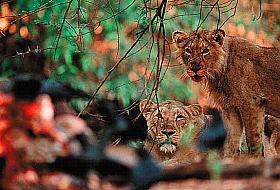
To book this space for your advertisement - contact us at enquiries@animal-web.com.

Lions
For all of their roaring, growling, and ferociousness, lions are family animals and truly social in their own communities. They usually live in groups of 15 or more animals called prides. Prides can be as small as 3 or as big as 40 animals.
In a pride, lions hunt prey, raise cubs, and defend their territory together.
In prides the females do most of the hunting and cub rearing. Usually all the lionesses in the pride are related—mothers, daughters, grandmothers, and sisters.
Many of the females in the pride give birth at about the same time. A cub may nurse other females as well as its mother.
Each pride generally will have no more than two adult males. While the females usually live with the pride for life, the males often stay for only two to four years. After that they go off on their own or are evicted by other males who take over the pride.
When a new male becomes part of the pride it is not unusual for him to kill all the cubs, insuring that all future cubs will have his genes.
The main job of males in the pride is defending the pride’s territory. A male’s loud roar, usually heard after sunset, can carry for as far as five miles (eight kilometers). The roar warns off intruders and helps round up stray members of the pride.
Hunting generally is done in the dark by the lionesses. They often hunt in groups of two or three, using teamwork to stalk, surround, and kill their prey.
Lionesses aren’t the most successful of hunters, because they usually score only one kill out of several tries. After the kill the males usually eat first, lionesses next—and the cubs get what’s left.
Males and females fiercely defend against any outside lions that attempt to join their pride. Maybe in this case the family that preys together stays together!
Range: parts of Africa and the Gir Forest of India
Habitat: grassy plains, savannas, open woodlands, and scrub country

Tigers
Easily recognized by its coat of reddish-orange with dark stripes, the tiger is the largest wild cat in the world. The big cat weighs up to 720 pounds (363 kilograms), stretches 6 feet (2 meters) long, and has a 3-foot- (1-meter-) long tail. The powerful predator generally hunts alone, able to bring down prey such as deer and antelope.
FUN FACTS:
No two tigers have exactly the same pattern of stripes.
Tigers that live in cold northern areas are usually bigger and heavier than those that live in tropical habitats.
Tigers wait until dark to hunt. Once a tiger has spotted its prey, it sneaks as close as possible to its victim. Then the tiger sprints to the unsuspecting animal, usually pulling it off its feet with its teeth and claws. If the prey animal is large, the tiger bites its throat to kill it; smaller prey is usually killed when the tiger breaks its neck.
Tigers have been known to eat up to 60 pounds (27 kilograms) of meat in one night, but more often they consume about 12 pounds (5 kilograms) during a meal. It may take days for a tiger to finish eating its kill. The cat eats until it’s full, and then covers the carcass with leaves and dirt. When it’s hungry again, the tiger comes back to feed some more, until the meat is gone.
Unlike most members of the cat family, tigers seem to enjoy water. They swim well and often soak in streams or pools of water to cool off.
Some tigers live where it gets very cold—in parts of North Korea, eastern Russia, and China. Other tigers live where the climate is generally warmer—in India and parts of southeast Asia. The whole species is endangered throughout its range. Tigers have been overhunted for their fur as well as for other body parts that many people use in traditional medicines. Tigers’ habitat has also dwindled seriously as humans have developed land for uses such as farming and logging.
Let us know your views
Send us your photos, information sheets, fun facts, and views on endangered animals or any wildlife or pets. If, like us, you love animals, we'd love to hear from you... You can contact our staff via e-mail on enquiries@animal-web.com.


 To book this space for your advertisement - contact us at enquiries@animal-web.com.
To book this space for your advertisement - contact us at enquiries@animal-web.com.

